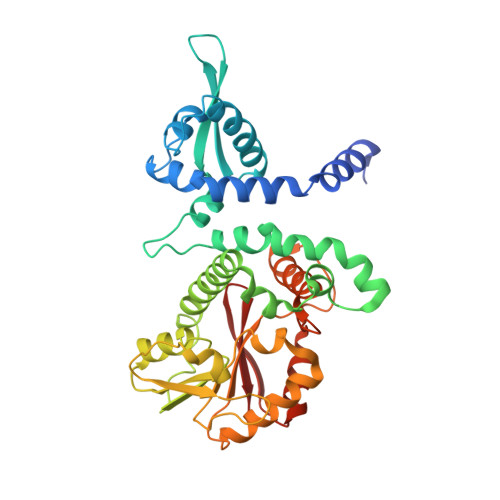Structural basis for the modulation of lignin monomer methylation by caffeic acid/5-hydroxyferulic acid 3/5-O-methyltransferase.
Zubieta, C., Kota, P., Ferrer, J.L., Dixon, R.A., Noel, J.P.(2002) Plant Cell 14: 1265-1277
- PubMed: 12084826
- DOI: https://doi.org/10.1105/tpc.001412
- Primary Citation of Related Structures:
1KYW, 1KYZ - PubMed Abstract:
Caffeic acid/5-hydroxyferulic acid 3/5-O-methyltransferase (COMT) from alfalfa is an S-adenosyl-L-Met-dependent O-methyltransferase involved in lignin biosynthesis. COMT methylates caffeoyl- and 5-hydroxyferuloyl-containing acids, aldehydes, and alcohols in vitro while displaying a kinetic preference for the alcohols and aldehydes over the free acids. The 2.2-A crystal structure of COMT in complex with S-adenosyl-L-homocysteine (SAH) and ferulic acid (ferulate form), as well as the 2.4-A crystal structure of COMT in complex with SAH and 5-hydroxyconiferaldehyde, provide a structural understanding of the observed substrate preferences. These crystal structures identify residues lining the active site surface that contact the substrates. Structurally guided site-directed mutagenesis of active site residues was performed with the goal of altering the kinetic preferences for physiological substrates. The kinetic parameters of the COMT mutants versus wild-type enzyme are presented, and coupled with the high-resolution crystal structures, they will serve as a starting point for the in vivo manipulation of lignin monomers in transgenic plants. Ultimately, this structurally based approach to metabolic engineering will allow the further alteration of the lignin biosynthetic pathway in agronomically important plants. This approach will lead to a better understanding of the in vivo operation of the potential metabolic grid for monolignol biosynthesis.
Organizational Affiliation:
Structural Biology Laboratory, Salk Institute for Biological Studies, La Jolla, CA 92037, USA.
















